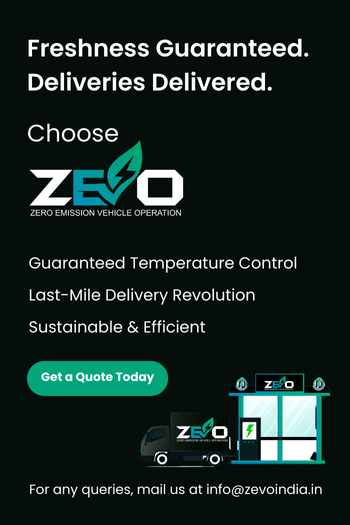How to Ensure Food Safety During Refrigerated Last-Mile Delivery (Downloadable Checklist Included)

Akshay Sharma
CEO's Office @ZEVO
In today’s fast-paced world, consumers are increasingly turning to convenient delivery options for their groceries and restaurant meals.
This has led to a surge in last-mile refrigerated delivery, where temperature-sensitive food items travel directly from the store or restaurant to the customer’s doorstep.
For delivery service providers, grocery stores, and food retailers, this presents an opportunity to expand your reach and tap into a growing market. But safe delivery is crucial.
Improper handling can lead to spoilage, compromised food quality, and ultimately, dissatisfied customers. The good news is that by implementing effective practices for temperature control, packing, and delivery optimization, you can guarantee the safe arrival of your refrigerated products.
Not only will this enhance customer satisfaction and loyalty, but it can also significantly reduce food waste, a major concern in the food industry.
This blog will serve as your comprehensive guide to mastering safe and efficient refrigerated last-mile delivery. We’ll unpack the essential steps to take, from selecting the right packaging and monitoring temperatures to optimizing delivery routes and educating your customers.
By following these best practices, you can ensure your customers receive fresh, delicious food every time, while safeguarding your reputation and boosting your bottom line.
Maintaining Safe Temperatures Throughout Delivery
The journey from farm to table takes many twists and turns, but for refrigerated food deliveries – the last mile – is critical. Here, maintaining proper temperatures is the absolute lifeline for ensuring food safety and quality.
Temperature Management Basics:
Not all cold foods are created equal. Different food categories have specific temperature requirements to stay safe and delicious. Understanding these needs is the first step.
- Meat, poultry, and seafood: These highly perishable items require the coldest temperatures, ideally at 4°C or below to prevent bacterial growth.
- Dairy products: Milk, cheese, and yogurt should also be kept at a cool 4°C to maintain freshness and quality.
- Fruits and vegetables: While some vegetables thrive in colder environments, most fruits and leafy greens prefer slightly warmer temperatures, typically around 7°C to prevent chilling damage.
By keeping these temperature ranges in mind, you can ensure your deliveries arrive in peak condition.
Packing for Temperature Control:
Now that you know the ideal temperatures, it’s time to choose the right packing techniques to maintain them. Here’s how to pack for success:
Specific Packing Techniques:
- Insulated containers: Invest in sturdy, insulated containers designed to retain cold air.
- Container size: Match the container size to the amount of food to minimize air circulation and temperature fluctuations.
- Grouping similar items: Group items with similar temperature needs together to maintain a consistent internal temperature.
- Ice packs or gel packs: Strategically placed ice packs or gel packs can provide an extra cooling boost, especially for highly perishable items.
Material Considerations:
- Insulation: Opt for packaging materials with good insulating properties, such as polystyrene foam or insulated cardboard.
- Sustainability: Consider eco-friendly alternatives like recycled materials or biodegradable insulation where possible.
Monitoring Temperatures During Delivery:
Maintaining the cold chain requires constant vigilance. Here’s how to monitor temperatures effectively:
- Traditional methods: Thermometers remain a reliable way to spot temperature deviations during delivery. However, they require manual checks, which might not be ideal for long journeys.
- Real-time temperature monitoring systems: Embrace the power of technology! Invest in real-time temperature monitoring systems that provide continuous data and alerts if temperatures deviate from the safe zone.
Benefits of Data Analysis:
Data analysis goes beyond simply monitoring temperature. By analyzing past delivery data, you can:
- Optimize delivery routes: Identify the most efficient routes to minimize travel time and temperature fluctuations.
- Predict potential risks: Anticipate potential issues based on weather forecasts or traffic patterns and take proactive measures.
This proactive approach allows you to go beyond reactive problem-solving and ensure consistent, safe deliveries every time.
Optimizing Delivery for Food Safety and Efficiency
- Invest in reusable containers: While upfront costs might be higher, reusable insulated containers are a sustainable and cost-effective option in the long run.
- Optimize container usage: Utilize different container sizes to match order volume, minimizing wasted space and unnecessary cooling.
- Strategic ice pack placement: Focus on strategically placing ice packs around highly perishable items instead of using excessive amounts.
- Partner with cold storage facilities: Consider partnering with cold storage facilities if you handle large volumes of refrigerated products.
Leveraging Technology for Efficient Temperature Management:
- Real-time temperature monitoring systems: As mentioned earlier, these systems provide invaluable data and alerts, allowing for proactive intervention and minimizing risks.
- Route optimization software: Utilize software that analyzes traffic patterns and weather conditions to find the most efficient delivery routes, reducing travel time and temperature fluctuations.
- Smart packaging: Explore emerging technologies like smart packaging that indicates spoilage or self-refrigerating containers for even more efficient temperature control.
Route Planning and Delivery Efficiency: Speed Meets Safety
Time is of the essence when it comes to maintaining safe temperatures. Here’s how to optimize delivery routes:
- Planning for traffic: Consider traffic patterns and peak hours while planning delivery schedules.
- Consolidation of deliveries: Consolidate deliveries in a specific area to minimize travel time and maximize efficiency.
- Data-driven route optimization: Utilize data analysis to identify optimal delivery routes based on historical information and current conditions.
By focusing on efficient route planning, you can ensure food arrives fresh and fast, while keeping your delivery operations streamlined.
Sustainability in Last-Mile Delivery
While efficient, refrigerated last-mile delivery offers a convenient solution, it’s crucial to consider its environmental impact. Packaging materials and refrigerated transport can contribute to increased energy consumption and waste generation.
Environmental Impact: A Look at the Cold Chain’s Footprint
- Packaging materials: Traditional single-use plastic or polystyrene containers create significant waste. Their production often relies on non-renewable resources and their disposal can contribute to landfill problems.
- Refrigerated transport: Fuel consumption by refrigerated vehicles contributes to greenhouse gas emissions. Additionally, maintaining cold temperatures requires energy, which may come from non-renewable sources.
Sustainable Alternatives and Eco-Friendly Practices: Delivering Responsibly
The good news is that you can make a difference:
- Reusable containers: Investing in a system of reusable, sanitized containers significantly reduces waste compared to single-use options.
- Sustainable packaging materials: Explore eco-friendly alternatives like recycled cardboard with insulated liners, biodegradable insulation materials, or even mushroom-based packaging.
- Optimize container usage: Choose the right size containers to minimize wasted space and maximize cold air retention, reducing the overall environmental footprint of packaging.
- Route optimization: By optimizing delivery routes for efficiency, you can minimize fuel consumption and associated emissions.
- Vehicle considerations: If replacing your fleet is feasible, consider transitioning to electric or hybrid vehicles to reduce emissions.
- Partnerships for sustainability: Explore collaborating with other delivery services in your area to consolidate deliveries and minimize the number of vehicles on the road.
Download Last-Mile Refrigerated Delivery Food Safety Checklist
This essential resource covers key steps to maintain temperature control, minimize spoilage, and comply with industry standards during the critical last-mile delivery stage. Download now to safeguard your products and deliver the highest quality to your customers every time.
Conclusion: A Win-Win for the Environment and Your Business
Implementing sustainable practices in your last-mile refrigerated delivery system is a win-win situation. You’ll be contributing to environmental responsibility, potentially reducing waste disposal costs, and appealing to a growing consumer base increasingly concerned about sustainability. By embracing these practices, you can demonstrate your commitment to a greener future while ensuring the safe and efficient delivery of fresh food to your customers.

Share this Article
Subscribe to our newsletter
Be the first to receive exclusive offers and the latest news on our products and services directly in your inbox.
